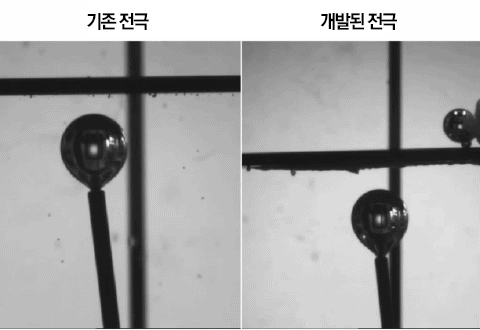Water drops falling on lotus leaves easily bounce off instead of being partially pinned on the surface. This is because of the irregular distribution of microbumps on the leaves, which has the property of repelling water. Taking cues from lotus leaves, a technique that significantly improves the efficiency of hydrogen production via the enhancement of electrode surfaces has been developed.
A research team, jointly led by Professor Jungki Ryu and Professor Dongwoog Lee in the School of Energy and Chemical Engineering has unveiled a new technique that gives an enhanced hydrogen production yield by 5 times via the deposition of highly porous superaerophobichydrogels on a desired electrode surface. This has attracted much attention as it significantly increases the hydrogen production efficiency without the need for developing new catalysts.
When a carbonated drink is poured into a glass, the CO2 gas that is dissolved in the beverage forms tiny bubbles that adhere to the inside surface of the glass. While these bubbles do not matter when drinking beverages, they can adversely affect many electrochemical systems. Indeed, in electrolytic cells, the bubbles formed on the surface of electrodes reduce the efficiency of reaction, which leads to energy losses. Therefore, it is important to remove the bubbles adhering to the electrode surface.

Figure 1. Effect of the superaerophobic hydrogel overlayer on the performance of Pt electrodes in hydrogen evolution reactions (HER).
To address these issues, the research team reported a simple strategy for the realization of superaerophobic electrodes via the deposition of hydrogels on a desired electrode surface. Hydrogel is a versatile class of cross-linked polymers that has the capability to absorb and retain a large amount of water and aqueous solutions. Besides, depositing hydrogels as coatings on solid surfaces can serve as an efficient removal of gas bubbles.
In the study, the research team measured the electrodes’ performance of gas evolution reactions (e.g., HER) based on the deposition of superaerophobic hydrogels on a target surface. Using M13 viral hydrogels as the model system, they found that the 3D porous structure of the viral hydrogel can impart superaerophobicity to the underlying substrate, thus readily eliminating gas bubbles. In addition, HER performance was substantially improved as a result of the separation of catalytically active and superaerophobic sites.
“Since polymers cannot serve as catalysts that accelerate chemical reaction and because they do not conduct electricity, they have been expected to lower the efficiency of water electrolysis,” says Professor Ryu. “Because of this, it has never been used for electrodes, but we were able to solve the shortcomings of the electrolysis method via the deposition of hydrogels on a desired electrode surface.”

(Left) Existing Electrode, (Right) Newly-developed Electrode
Their work has attracted the attention of many researchers, as a new technology to impart bubble-repellent properties (so-called superaerophobicity) via the deposition of superaerophobic hydrogels on a solid surface. Although researchers have attempted to impart superaerophobicity to electrodes by controlling the microstructures of solid surfaces, conventional approaches have limitations, as they are material specific, difficult to scale up, possibly detrimental to the electrodes’ catalytic activity and stability, and incompatible with photoelectrochemical applications. The new method can be applied to any solid materials, and thus have a wide range of applications, as it only requires only the deposition of hydrogels on a desired electrode surface. In addition, their approach could also be successfully applied to photoelectrodes due to the transparency of hydrogel; by contrast, conventional approaches, which rely on the nano- and microfabrication of electrodes, have lower transparency.
“This is the first study to realize bubble-repellent properties (so-called superaerophobicity) on the surface of various solids via the deposition of hydrogels on a desired electrode surface,” says Professor Lee. “This study can provide insight into a simple method for the design and fabrication of efficient power- and solar-to-gas conversion devices.”
This study has been participated by Dasom Jeon (Doctoral program of Energy and Chemical Engineering, UNIST) and Jinwoo Park (Combined M.S/Ph.D. of Energy and Chemical Engineering, UNIST), as co-first authors of the study. Supported by the Korean National Research Foundation (NRF), their findings have been published in Science Advances on April 10, 2020.
Journal Reference
Dasom Jeon1, Jinwoo Park, Changhwan Shin, et al., “Superaerophobic hydrogels for enhanced electrochemical and photoelectrochemical hydrogen production,” Science Advances, (2020).













